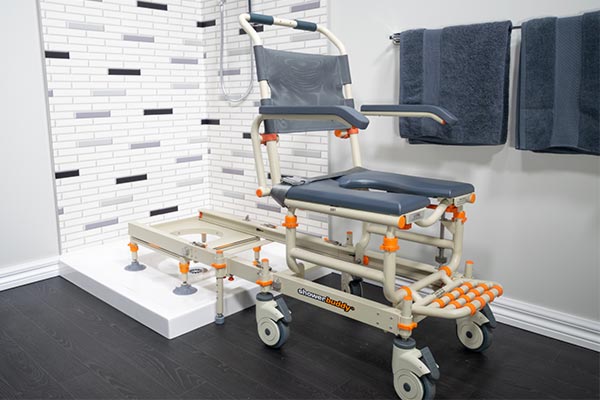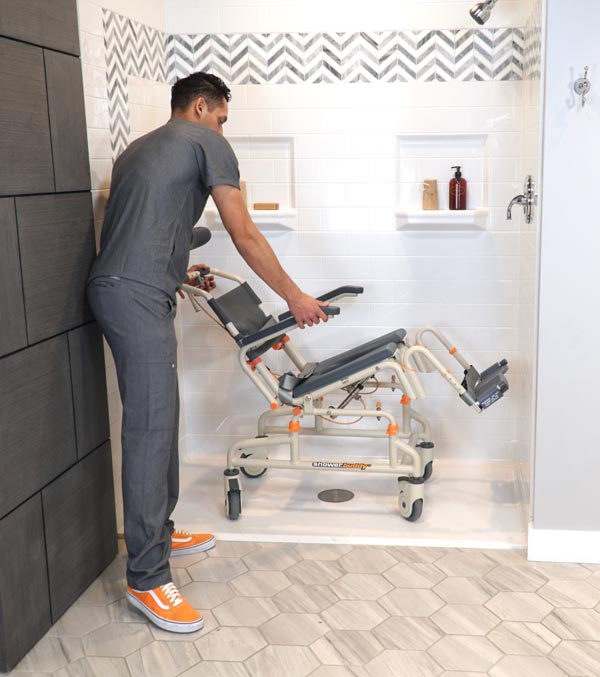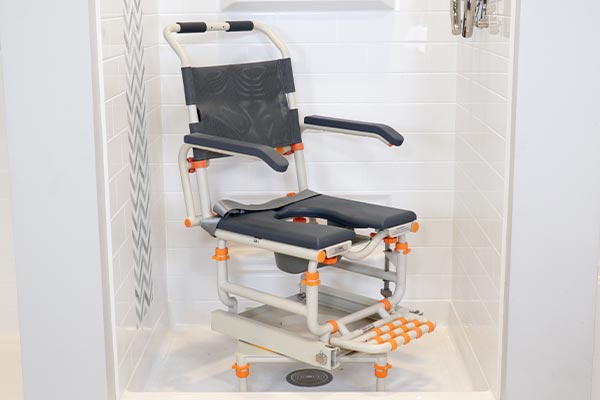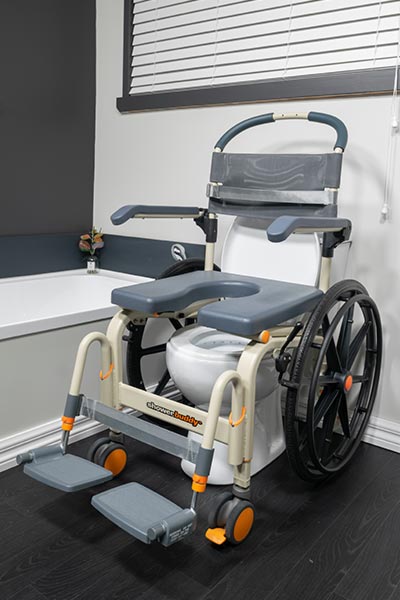-
A shower chair is a popular assistive technology for any individual experiencing loss of mobility due to a disability.
With an estimated 1-200 million significant disabilities worldwide, there’s plenty of demand for equipment to help live daily life. However, while some assistive technology provides a basic function across most variations, shower chairs vary greatly in terms of their capabilities and quality.
In this guide, we’ll provide OTs, families, and disabled individuals with some important things to know as they research potential shower chairs.
-
![]()
MODEL SB1: The modular chair and track system is designed to clear raised shower tray edges. Once the chair is locked in the shower position the front bridge tracks can be remove to aid carer access.
-
Support what: you need
-
Choose a shower chair that properly supports your needs
Before a shower chair can be deemed as appropriate for a disabled person, there needs to be a proper assessment of what their specific needs are.
Physical disability only
In the case of physical disabilities only, the individual should form a key part of this assessment, identifying the particular areas of bathroom movements that are a challenge.
Combined mental and physical disability
For those with a combined mental and physical disability, the assessment by healthcare providers will make a determination on support requirements now and likely in the future.
-
![]()
Build: a plan
-
Building the OT plan
Once there’s a full picture of the disability, an occupational therapist (OT) can assist with building out a daily action plan that includes the bathroom routine. They’ll assess the individual’s home, support system and own preferences to build out a process that suits everyone. This plan should also outline the types of assistive technologies that are required, as well as some guidance around accessing these. Showerbuddy works closely with OTs every day to bring the benefits of our system to more homes navigating disability.
Why low quality options don’t suit serious disabilities
Any serious mobility impairment will not be adequately addressed with a cheap, low quality shower stool from a local homeware store. Rather, these products could cause more issues than benefits, with their inability to provide physical support and bathing movements properly to someone who lacks the function to stabilise themselves.
Anyone with a serious physical disability may also be unable to carry out the movements involved in transferring into the bathtub or shower. For these scenarios, a full transfer system is highly valuable, reducing the amount of manual effort for everyone involved.
When “high care”: is needed
-
![]()
-
Additional supports required for high care disabilities
Our community of users come from all backgrounds and disabilities. We support quadriplegics, multiple sclerosis, stroke, muscular dystrophy and hundreds of other conditions. When an individual is unable to move their limbs or have control over body positioning generally, a shower chair needs to provide support beyond seating.
As you look for shower chairs to accommodate a serious disability, you’ll want to consider the following:
- Does the chair have good back support that can accommodate irregular posture or body position?
- Is there a neck rest support that can keep the user’s head in place?
- Is transferring possible with virtually no input from the user?
- Can the chair tilt and maneuver over the edge of a bathtub or other barrier?
- Is there a seatbelt to keep the user in place throughout bathing and transfers?
- Does the shower chair have foot and arm rests to help maintain a seated position?
- Does the shower chair have the ability to swap out the seat to accommodate certain commode requirements?
Many standard shower chairs do not offer these functions making them less than perfect for a user who requires maximum support throughout bathing. This can also demand more from a family member or carer.
Consider the bathroom format and shower type
You should take care to understand the dimensions and format of your bathroom to work out if it will accommodate potential shower chairs you’re researching.
Some chairs may be functionality appropriate but upon trying to install prove to be too large. This is why engaging an occupational therapist is a crucial step in the process of getting assistive equipment like a shower chair. Showerbuddy has developed a web and mobile based app called BathCheck, designed to guide people through measuring a bathroom for confirmation it can use our chairs. While there’s a Showerbuddy designed for almost every size and type of bathroom, many products on the market don’t. Regardless of which model and brand you go with, measuring and planning shouldnt be skipped over.
-
![]()
Making the: right choice
-
Determine if you need a portable shower chair option
For any disabled user of a shower chair who is frequently travelling or moving between homes, it may be worth investigating a portable option. This format should still offer most of the support and comfort of less portable solutions, but with the added convenience of a quick and compact pack-down.
When looking for a portable shower chair, don’t make the mistake of choosing a solution that takes shortcuts around build quality. Unfamiliar bathrooms present more opportunities for hazards, so the assistive equipment that comes with the individual should help to reduce these risks. That means sturdy build, brakes to keep stable and high comfort cushions.
A portable shower chair might not necessarily be used instead of a standard chair kept in the home, but rather additional to it. Ultimately the mobility impaired individual and their OT will determine the best combination of equipment to meet daily demands.
Is a self-propelled option better for you?
If you’ve got a physical disability that allows you mostly or total solo operation of a wheelchair, then you may wish to find a shower chair solution that closely resembles this method. We’re talking about shower chairs that are designed like wheelchairs, but specifically for the bathroom with water resistant build, commode function and stability features to keep locked down to a wet room style shower. If your bathroom allows for direct roll-in access, you may prefer this option. Sometimes a carer may be required for some of the process, but a self-propelled chair drastically reduces this involvement.
You can read more about wheelchairs and bathrooms in our dedicated guide.
Look into funding for equipment to access better quality solutions
Funding is a great way to get access to equipment that might otherwise be out of the budget. You may be able to access funding for your shower chair with your disability. Each region or country is different when it comes to funded assistive technology, so take a look at our funding page for more information about getting your shower chair paid for.
Buy a shower chair that lasts the distance for evolving disabilities
It translates to many product categories, but the adage of buying once, buy well really does apply to shower chairs. In many disabilities, the current mobility needs of the individual are likely to change in the future, whether it’s improving through rehabilitation, or reducing such as in the case of a degenerative condition or simply aging.
Our buying advice for disabled people and their families is to find a shower chair that not only lasts the distance through build quality, but offers adjustment and accessories to ensure the chair continues to be fit for purpose. At the same time, pick a chair that provides good support and warranty as this can further reduce your lifetime costs and hassle.
-
Avoid low quality
-
Avoid low quality bath chair options
Anyone with any mobility impairment beyond low level fatigue should avoid cheap and poorly made shower chairs. These are tempting as they can be picked up for under $100. The reality is that these items rarely last the distance, requiring replacement. Worse still, they don’t adequately support someone with a disability who in some cases may make irregular body movements that could tip over a poorly made product.
Low quality shower stools also don’t allow the user to properly enjoy bathing; they’ll typically require more support from a carer or family member, meaning that users can’t enjoy long periods of solo bathing. We strongly believe that everyone has the right to a comfortable, dignified shower each day. A proper shower chair system will use some of the features we’ve covered so far to keep the user in place without additional manual support, providing opportunities for carer-free bathing (under supervision). Buying cheap means buying frequently. The lifetime cost of using poor quality shower chairs can end up being comparable or more expensive than a good shower chair – a consideration that may not even be applicable if local health funding allows for full coverage of a sophisticated shower chair.
Learn more about Showerbuddy’s: range for disabled users
Showerbuddy provides an incredible range of shower chair systems based upon the principles of making showering enjoyable and dignified for all. Head over to our products section where you can see our full range, or simply use our main navigation to find a particular category of shower chair that suits your needs.





